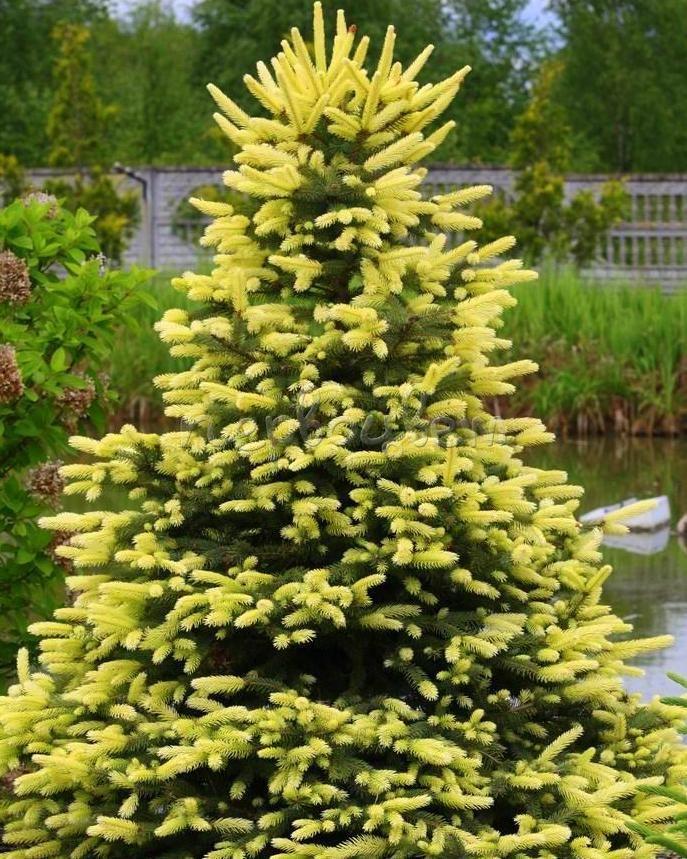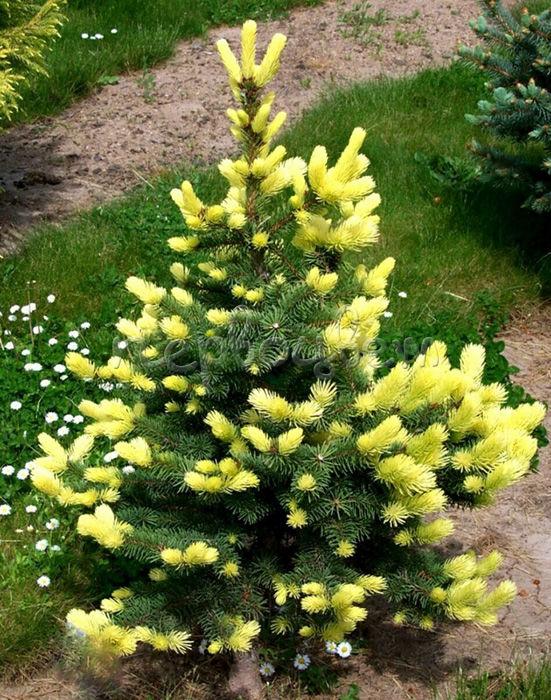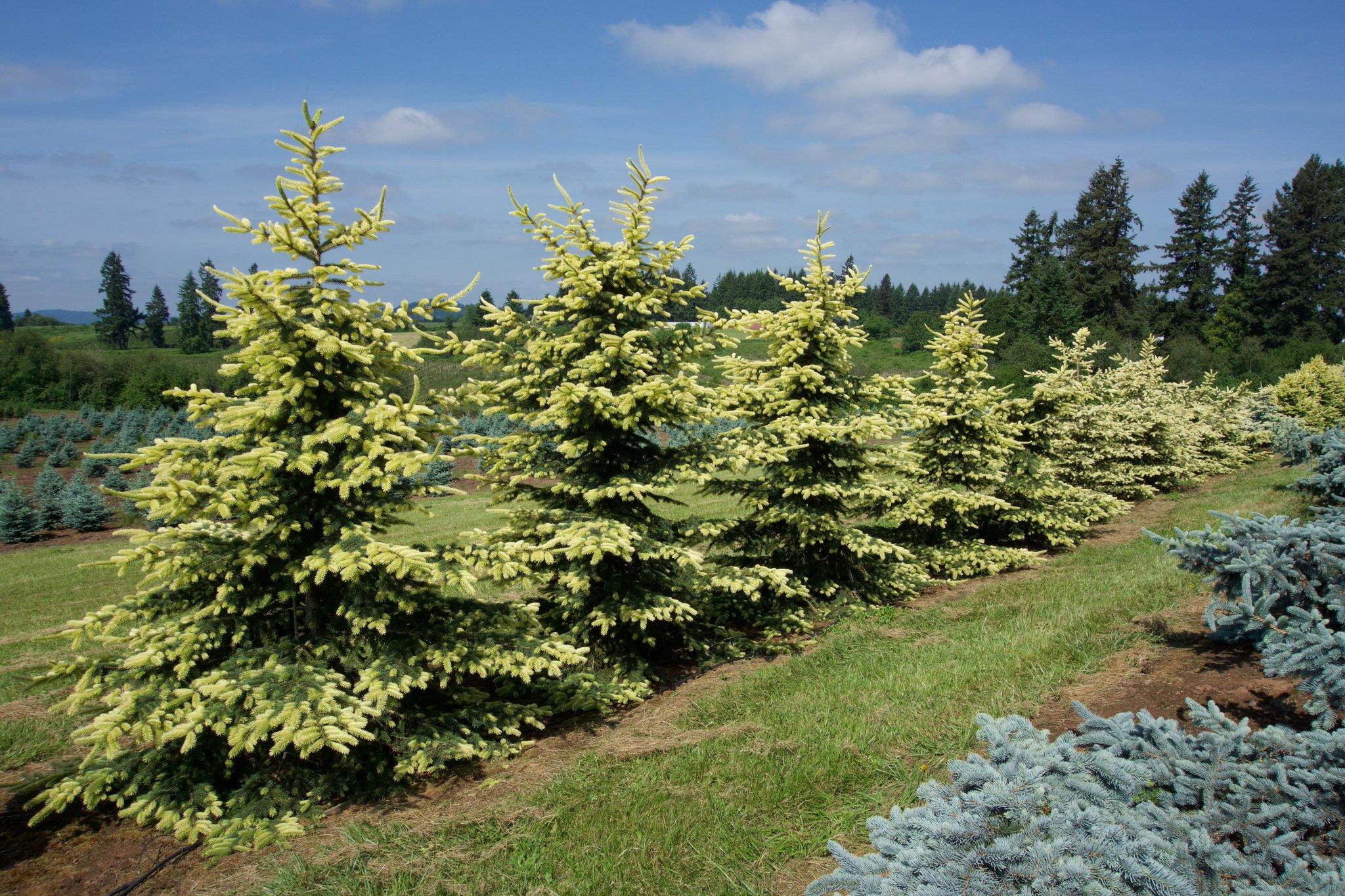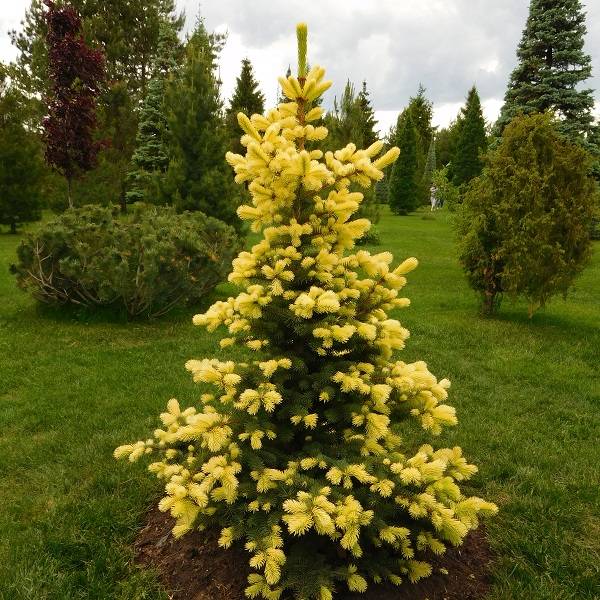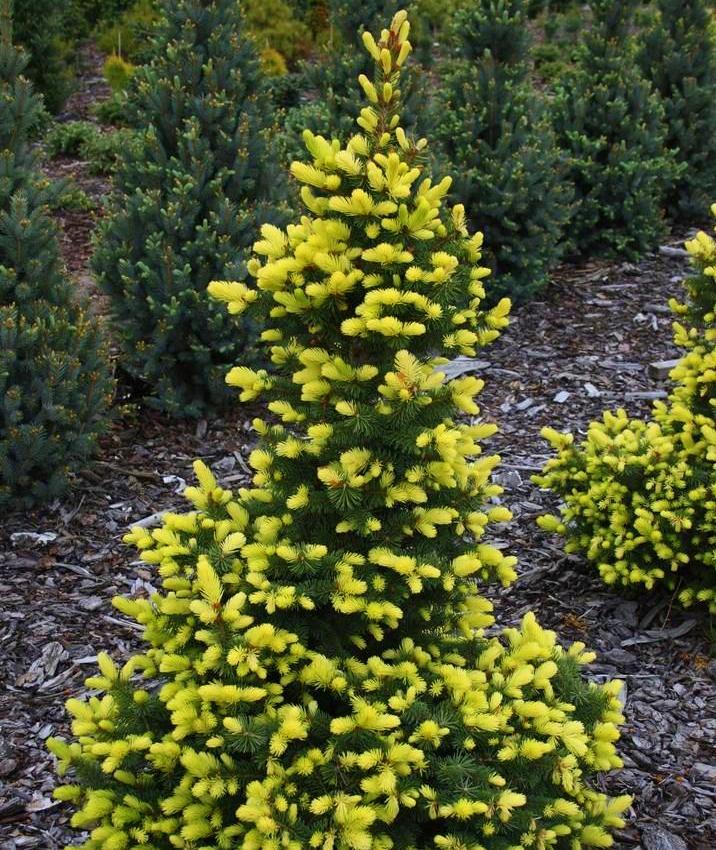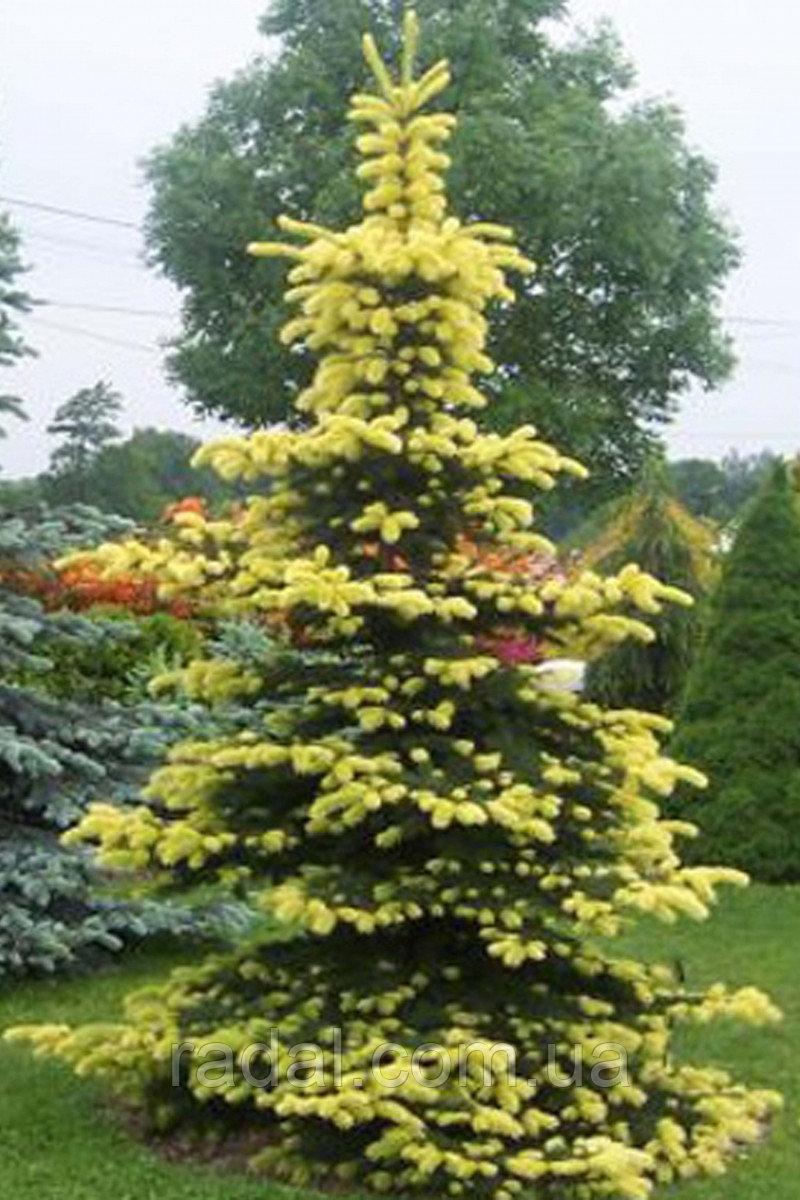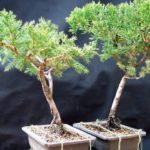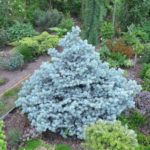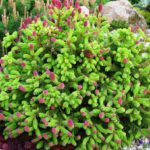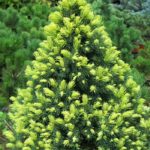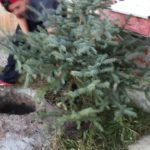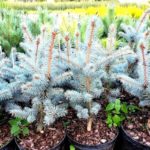Maigold prickly spruce is an attractive ornamental tree. When grown at home, the crop does not exceed 30-40 centimeters in height. When planted in open soil, the plant reaches 2-4 meters. The first mentions of this plant date back to the beginning of the last century. North America is considered the birthplace of the culture. Despite the unpretentiousness of the culture, to preserve its decorative properties it must be properly cared for.
Description of the tree
Maigold prickly spruce is considered a fairly common coniferous tree that has an attractive appearance. Its crown has the shape of a wide cone. Under natural conditions, the tree reaches 2-4 meters in height.
A distinctive feature of the culture is the annual growth of shoots, which gives the needles an interesting golden color. At the same time, last year’s needles have the usual green tint.
The Maigold variety is characterized by its compact size and resistance to frost. The plant is considered very unpretentious. When growing a crop in a summer cottage, it requires minimal care. By the age of 10, the height of the tree is usually 2.5 meters. Spruce is characterized by short shoots, which are almost always located horizontally. The tree has superficial roots that are quite widely branched.
Application in landscape design
Spruce of this variety is actively used in landscape design. It is used to decorate garden and park areas. The culture is used as a tapeworm or to create compositions with other conifers or herbaceous plants.
Landscape designers often use this plant. This is due to the unusual color of its needles. Young needles have a golden-yellow hue, while old ones are green. Due to this, the culture looks very decorative.
When using spruce in landscape design, various options are possible. Culture can be applied in the following ways:
- as the main accent in the garden;
- in a rock garden;
- in a rocky garden;
- as part of a decorative composition.
Since the tree is characterized by compact dimensions, it is recommended to be used in small spaces. Migold spruce looks great with taller crops.This plant can be combined with trees that have a different color of needles or a different height.
Landing Features
Maigold spruce is considered a very unpretentious plant. However, to obtain the desired level of its decorative effect, it is important to carry out planting work correctly. In this case, the choice of seedlings is of great importance. To make future plants look attractive, some effort is required.
How to choose a seedling
When purchasing a Canadian spruce, you need to carefully inspect the seedling. With the arrival of spring, the Maigold variety changes its color. It is important to consider that the wood in the catalog or in the photo may have a different shade. Also, a young culture may have significant differences from a mature one. This is due to the characteristics of vegetative propagation.
When purchasing a seedling, it is important to consider that it should not have damage to the roots, mold or rot. It is worth considering that by the time of purchase the tree must have been growing in a container for at least 6 months. To appreciate this feature, it is worth paying attention to the drainage holes through which the plant takes root.
When buying a grafted spruce, you should also take into account some features. In the grafting area, the plant should not have cracks larger than 1 millimeter. Also, there should be no peeling of the bark on the surface. If a seedling has symptoms of disease or pest damage, you should refuse to purchase it.
It is also important to consider that the needles must be securely attached to the branches.If it falls off when touched, it means the seedling is not of very high quality. At the time of purchase, it is necessary to inspect neighboring plants. If there are differences in color or traces of pruning at the bottom, you should not buy a tree.
Moreover, even the straightest seedling may have fewer branches on a certain side. This is considered a variant of the norm. Subsequently, the crown can be adjusted. This requires pruning or pinching the shoots.
Preparing the hole and soil
Like Konik, Maigold spruce must be planted exclusively in pre-prepared soil. Its composition must necessarily include high-moor acidic peat. The hydrogen parameter should be at 4.5. If the soil on the site is quite acidic, it is permissible to use another alkaline substrate.
For mulching, you need to mix fine pine bark and chopped spruce branches. When planting a crop in the ground, it needs to be moistened abundantly. If the seedling has closed roots, it can be planted at any time of the year. In this case, you need to take the plant out of the container with extreme caution.
Before planting, it is recommended to keep the root system of the tree in a special solution. It is advisable to treat the entire seedling with chemicals. Some types of soil require the addition of additional components - peat, sand, conifer sawdust, bark. This is especially important to do when planting trees in loamy soil or so-called heavy black soil. Of no small importance is the addition of 100 grams of nitroammophoska to the soil.
Landing algorithm
According to the description, the tree must be planted correctly. It is recommended to do the following:
- Select and carefully inspect planting material.
- Prepare the soil using mulch and a mineral complex.
- Prepare a spruce seedling.
- Plant the plant in open soil.
After planting, the plant needs to be watered systematically. For 1 tree you should use at least 1 bucket of water. Every week it is necessary to loosen the soil. The plant is characterized by a superficial location of the roots, therefore this procedure is carried out at a depth of no more than 5-7 centimeters.
Peat must be used as mulch. Subsequently, it is mixed with soil and reused as fertilizer. Normal development of spruce is possible only with high-quality removal of all weeds from the soil surface. Perennials can cause particular harm to spruce.
Care requirements
In order for a culture to grow and develop normally, it needs to be properly cared for. It is important to consider that the crop should be watered and fed in a timely manner.
Watering and fertilizing
When feeding spruce, it is recommended to use a maximum of 3 grams of fertilizer per 1 kilogram of soil. In this case, the seasonal factor must be taken into account. In the spring, the plant needs nitrogen substances; in the summer, phosphorus preparations should be applied, and in the fall - potassium preparations. Migold accepts both chemical and natural fertilizers well. However, if there is an excess amount of such substances, the tree suffers or lags behind in development.
If the soil contains a little sand, you should use compost or humus as a top dressing. Thanks to the addition of organic matter, it is possible to significantly improve the overall soil performance, increase the flow of oxygen and stimulate the development of beneficial bacteria. If the procedure is carried out correctly, many worms will appear on the site. This will help reduce the need for expensive mineral supplements.
For full development, spruce needs a lot of water. Therefore, it is necessary to water the plant systematically.At the initial stage of growth, immediately after transplantation and in the following year, the tree must be moistened with at least 10 liters of water. Subsequently, this amount can be reduced to 5-7 liters. In this case, it is worth focusing on the weather. If there is a lot of precipitation in the summer, the amount of moisture should be reduced.
Trimming
The culture of this variety withstands pruning well. However, she does not require constant care. It is recommended to artificially remove branches for the first time if the crown is asymmetrical. At the beginning of spring, sanitary pruning is carried out. During this procedure, it is worth getting rid of dry and damaged branches. Also at this moment it is necessary to remove new shoots that have been damaged by frost.
To protect the tree from pathogens and ensure its normal development, cut areas must be treated with fungicides. Fertilizer may also be required. These procedures are of great importance because they promote normal development, activate the growth of new shoots and protect against the development of pathologies and parasite attacks.
Pest Control
Migold spruce often faces spruce aphid attacks. These insects are considered very dangerous for coniferous plants. Under the influence of these pests, yellowish spots form on green needles. After some time, the needles fall off.
Another dangerous pest that often affects Maigold spruce is the gall aphid. It comes in red and yellow. These parasites suck out all the juices from the young shoots of the tree.As a result, galls form on the needles. They are similar in appearance to pineapple. After some time, such branches die off.
Another dangerous parasite is the nun moth. Its larvae are black or off-white. They absorb the needles to the very base. The caterpillars reach a length of 5 centimeters. Sometimes, under the influence of parasites, the branches acquire a brownish-brown color. This is due to the development of a fungal infection, which mainly affects the lower branches of the conifer.
During prolonged drought, the tree can be affected by spider mites. Their larvae weave a translucent cocoon from a web. They live there and suck nutrients from the spruce. Under the influence of these parasites, the plant's needles suffer. After identifying the pest, you need to choose a means to combat it.
In spring and mid-summer, it is important to carry out preventive treatments with insecticidal preparations. For this purpose, it is permissible to use such means as “Aktara”, “Enzhio”, “Match”. To cope with pathologies, it is necessary to use fungicides. The most effective substances include “Switch”, “Skor”, “Ordan”.
In addition to visible pathologies and parasites, there are those that develop directly in the soil. One of the most common and dangerous parasites is the May beetle. To cope with it, you need to use chemical insecticides. Depending on the variety and instructions, the product is recommended to be used during watering. This should be done closer to the root system.
The crown is treated with chemicals starting at the end of April. This procedure must be performed at intervals of 40 days. This must be done until September.
Weeds pose a great danger to the Maigold prickly spruce. In this case, the plant lags behind in development and may even die. To avoid such problems, weeds must be removed from the soil surface monthly.
Herbicides also help fight unwanted vegetation. One of the most effective remedies in this category is Roundup. To treat a young tree, 1 liter of active ingredient is enough. It is recommended to use more than 3 liters of the substance for an adult spruce.
Maigold spruce is a very attractive ornamental plant that is used to create various garden compositions. In order for a tree to maintain its attractiveness, it needs to be provided with complete and high-quality care. It should include regular watering, the addition of nutrients, and formative and sanitary pruning. Timely control of diseases and pests is of no small importance.

